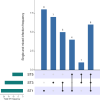Gut microbiota profiles in diarrheic patients with co-occurrence of Clostridioides difficile and Blastocystis
- PMID: 33725006
- PMCID: PMC7963057
- DOI: 10.1371/journal.pone.0248185
Gut microbiota profiles in diarrheic patients with co-occurrence of Clostridioides difficile and Blastocystis
Abstract
Blastocystis and Clostridioides difficile co-occurrence is considered a rare event since the colonization by Blastocystis is prevented under a decrease in beneficial bacteria in the microbiota when there is C. difficile infection (CDI). This scenario has been reported once, but no information on the gut microbiota profiling is available. The present study is motivated by knowing which members of the microbiota can be found in this rare scenario and how this co-occurrence may impact the abundance of other bacteria, eukaryotes or archaea present in the gut microbiota. This study aimed to describe the bacterial and eukaryotic communities using amplicon-based sequencing of the 16S- and 18S-rRNA regions of three patient groups: (1) Blastocystis and C. difficile infection (B+/C+, n = 31), (2) C. difficile infection only (B-/C+, n = 44), and (3) without Blastocystis or C. difficile (B-/C-, n = 40). Blastocystis was subtyped using amplicon-based sequencing of the 18S-rRNA gene, revealing circulation of subtypes ST1 (43.4%), ST3 (35.85%) and ST5 (20.75%) among the study population. We found that B+/C+ patients had a higher abundance of some beneficial bacteria (such as butyrate producers or bacteria with anti-inflammatory properties) compared with non-Blastocystis-colonized patients, which may suggest a shift towards an increase in beneficial bacteria when Blastocystis colonizes patients with CDI. Regarding eukaryotic communities, statistical differences in the abundance of some eukaryotic genera between the study groups were not observed. Thus, this study provides preliminary descriptive information of a potential microbiota profiling of differential presence by Blastocystis and C. difficile.
Conflict of interest statement
The authors have declared that no competing interests exist.
Figures




Similar articles
-
Blastocystis and Clostridioides difficile: Evidence for a Synergistic Role in Colonization Among IBD Patients with Emphasis on Ulcerative Colitis.Turk J Gastroenterol. 2021 Jun;32(6):500-507. doi: 10.5152/tjg.2021.19644. Turk J Gastroenterol. 2021. PMID: 34405816 Free PMC article.
-
Prevalence and molecular subtyping of Blastocystis in patients with Clostridium difficile infection, Singapore.Parasit Vectors. 2021 May 24;14(1):277. doi: 10.1186/s13071-021-04749-8. Parasit Vectors. 2021. PMID: 34030712 Free PMC article.
-
Diluted Fecal Community Transplant Restores Clostridioides difficile Colonization Resistance to Antibiotic-Perturbed Murine Communities.mBio. 2022 Aug 30;13(4):e0136422. doi: 10.1128/mbio.01364-22. Epub 2022 Aug 1. mBio. 2022. PMID: 35913161 Free PMC article.
-
Microbe-microbe interactions during Clostridioides difficile infection.Curr Opin Microbiol. 2020 Feb;53:19-25. doi: 10.1016/j.mib.2020.01.016. Epub 2020 Feb 20. Curr Opin Microbiol. 2020. PMID: 32088581 Free PMC article. Review.
-
Blastocystis in Health and Disease: Are We Moving from a Clinical to a Public Health Perspective?J Clin Microbiol. 2016 Mar;54(3):524-8. doi: 10.1128/JCM.02520-15. Epub 2015 Dec 16. J Clin Microbiol. 2016. PMID: 26677249 Free PMC article. Review.
Cited by
-
Microbial Interdomain Interactions Delineate the Disruptive Intestinal Homeostasis in Clostridioides difficile Infection.Microbiol Spectr. 2022 Oct 26;10(5):e0050222. doi: 10.1128/spectrum.00502-22. Epub 2022 Sep 26. Microbiol Spectr. 2022. PMID: 36154277 Free PMC article.
-
An update on the distribution of Blastocystis subtypes in the Americas.Heliyon. 2022 Dec 24;8(12):e12592. doi: 10.1016/j.heliyon.2022.e12592. eCollection 2022 Dec. Heliyon. 2022. PMID: 36619449 Free PMC article.
-
Identification of Multiple Blastocystis Subtypes in Domestic Animals From Colombia Using Amplicon-Based Next Generation Sequencing.Front Vet Sci. 2021 Aug 24;8:732129. doi: 10.3389/fvets.2021.732129. eCollection 2021. Front Vet Sci. 2021. PMID: 34504891 Free PMC article.
-
Updating changes in human gut microbial communities associated with Clostridioides difficile infection.Gut Microbes. 2021 Jan-Dec;13(1):1966277. doi: 10.1080/19490976.2021.1966277. Gut Microbes. 2021. PMID: 34486488 Free PMC article. Review.
-
Prevalence of Blastocystis and its association with Firmicutes/Bacteroidetes ratio in clinically healthy and metabolically ill subjects.BMC Microbiol. 2021 Dec 11;21(1):339. doi: 10.1186/s12866-021-02402-z. BMC Microbiol. 2021. PMID: 34895145 Free PMC article.
References
Publication types
MeSH terms
LinkOut - more resources
Full Text Sources
Other Literature Sources
Medical

